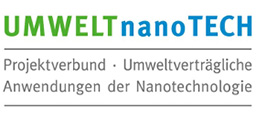UMWELTnanoTECH
ENVIRONMENTALLY COMPATIBLE APPLICATIONS OF NANOTECHNOLOGY

7 Nanostructured thermoelectric materials
Field of work:
ThermoelectricityThermoelectric materials allow the direct and wear-free conversion of thermal energy into electric energy and vice versa. They are already applied for cooling applications and will in the future constitute an important building block for the environmentally friendly generation of electric power from waste heat, for example from cars and industrial systems, or for the operation of sensors not connected to the electricity grid.
The efficiency of thermoelectric materials is primarily determined by their specific electric and thermal conductivities and the temperature, at which the thermoelectric device is operated. Currently, the thermoelectric converters available for low operating temperatures primarily consist of lead or tellurium compounds, both not environmentally friendly in terms of toxicity and sustainability. In contrast, silicon-germanium alloys which, until now, tended to be used at higher temperatures, are more sustainable and non-toxic.
It is the goal of the project to expand the thermoelectric range of application of silicon-germanium alloys to lower temperatures. Nanostructuring of the material and the resulting reduction of thermal conductivity offer a promising approach for this purpose. Here the presence of nanostructures on different length scales is decisive. This can be achieved, for example, through the systematic integration of inclusions, grain boundaries and porosity.
In this project, we fabricate micro- and nanostructured silicon-germanium layers starting from silicon and germanium nanoparticles. For this, a laser sintering process is used based on nanoparticle inks. A process to dope the materials obtained developed by the research group is optimized in order to reduce its toxicity, to make maximum use of the raw materials and to increase its applicability for inkjet-based print processes. The project collaborates with the University of Applied Sciences Nuremberg Georg-Simon-Ohm to develop thermoelectric generators. For this purpose, our group in Garching optimizes Si nanoparticle inks for inkjet printing regarding their viscosities and the Nuremburg group generates test structures from these inks. The characterization of the microscopic properties of the mesoporous films obtained via laser sintering is carried out in collaboration with the University of Applied Sciences in Deggendorf. Initial toxicological tests of the University Clinic of Erlangen show that the cell cultures studied are comparatively resistant to germanium nanoparticles while some types of silicon particles result in reactions.
Two studies on the heat conductivity of SiGe films were published by the Garching group. , On the international level, a symposium on nanoparticles was organized by the project manager at the Spring Meeting of the Materials Research Society in San Francisco and work in the project was presented there as part of a presentation by a project employee.



